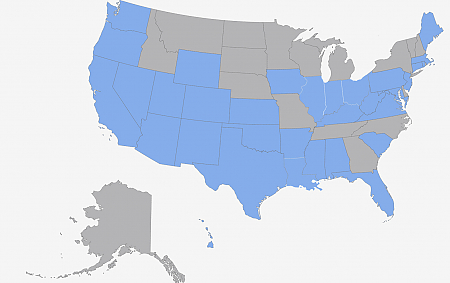U.S. states with laws, initiatives, or resolutions related to dyslexia (shown in blue).*

*As of December, 2015. Source: Youman, M.,& Mather, N. (2015). Dyslexia Laws in the USA: An Update. Perspectives on Language and Literacy.
In response to recent state and federal legislation mandating renewed focus on dyslexia, LCIRT has updated its professional development services for schools and colleges around dyslexia screening, interventions, and teacher training.
Our customized onsite workshops or online webinars offer contemporary understanding of dyslexia neuroscience and pedagogy for all levels. LCIRT offers high quality Professional Development to K-12 schools and colleges, as well as to teacher preparation programs that want to deepen their understanding of dyslexia.
A series of face-to-face, onsite workshops or online webinars can provide support to educators in the following areas:
Examines etiology, neurodevelopmental pathways, brain signatures, prevalence and characteristics, as well as a brief overview of the history of dyslexia research, interventions and legislation.
Helps educators understand typical signs of dyslexia at different developmental stages, as well as individual variations in functional limitations.
Identifies the key to scientifically-validated remediation, based on familiarity with the phonology, orthography, and morphology of words in English, since these form the basis for instruction that develops accurate and automatic application of the alphabetic principle when decoding words
Examines how early intervention can help prevent reading failure. Learn classroom-tested and scientifically valid programs and approaches based on systematic, language-based, multi-sensory instruction.
Looks at how to assess individual progress and evaluate programs, including early screening and ongoing progress monitoring.

*As of December, 2015. Source: Youman, M.,& Mather, N. (2015). Dyslexia Laws in the USA: An Update. Perspectives on Language and Literacy.
“Dyslexia is a specific learning disability that is neurobiological in origin.”
- International Dyslexia Association, 2002
It is characterized by:
Students with dyslexia have difficulty processing sounds of language accurately and automatically. Even before students learn to read, there are predictive symptoms that include difficulty with:
Even after students learn the early stages of reading, spelling and writing, there may be persistent signs of dyslexia that include:
Early interventions (in primary grades) are most effective in preventing or minimizing the negative impact of dyslexia on academic success and self-image. These include:
However, Landmark College is proof that interventions for older students with dyslexia work, including:
LCIRT offers schools and colleges professional development in all these areas via: